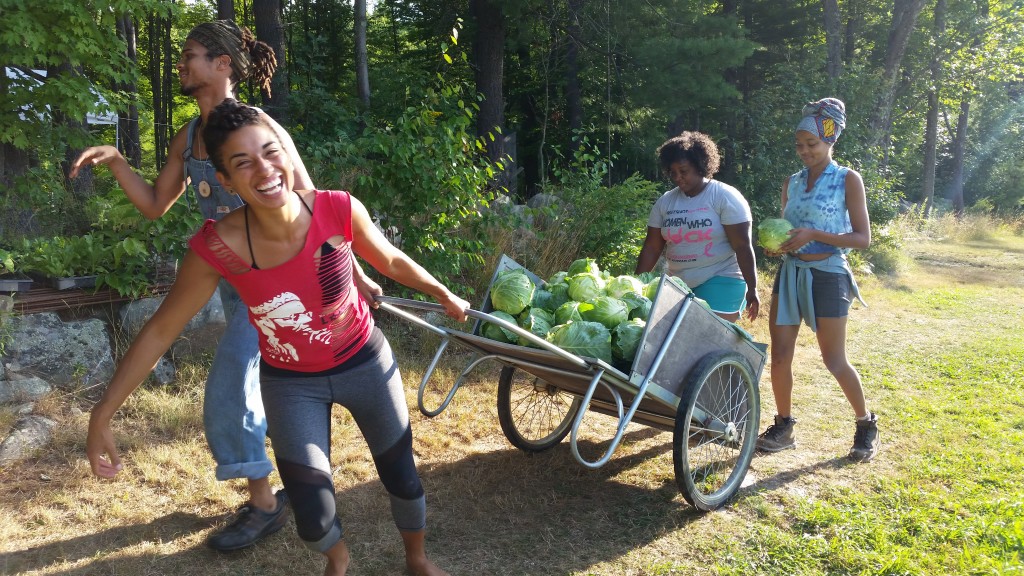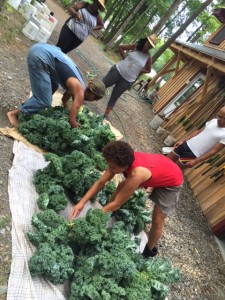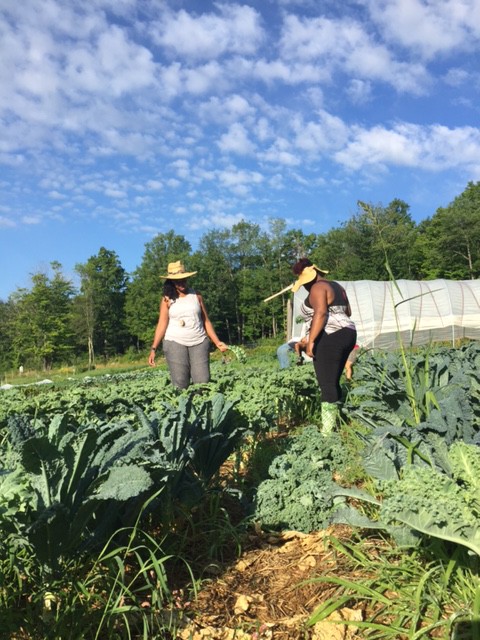Love Notes #7, July 25, 2016
By: Leah Penniman
- Contents of Share
- Announcements
- Farm and Food Justice News
- Recipe and Food Preservation Tips
Naima stepping in for 24 hours to help lead Black and Latinx Farmers Immersion (BLFI) while Mama Leah rests and heals. Look how hard she is working to pull that cabbage while Chris is dancing on the other side of the handle bar. 🙂
CONTENTS OF SHARE
- Green cabbage (1 head)
- Rainbow chard (1 bunch)
- Green garlic (2-3 bulbs) – Do not store these in the fridge. Leave them out in a dry space on the counter and they will continue to cure and keep for months. But eat them soon cause they’re delicious and you’re gonna bet a lot more.
- Cilantro (1 bunch)
- Lettuce (1-3 heads)
- Winterbor kale (1 bunch)
- Turnips or beets (1 bunch)
- Carrots (1 bunch)
- Zucchini and/or yellow summer squash (2 pounds)
- Green string beans (1.5 pounds)
- Yellow string beans (0.5 pounds)
- Optional: lentil sprout mix
The BLFI 2 mulch team looking fresh and fly. Photo credit: Shanelle Donaldson West
ANNOUNCEMENTS
- PASTURE-RAISED CHICKEN. We are also processing our chickens today, right now! They can be picked up on the farm or delivered on our normal Wednesday delivery route next week. You can pay using EBT/SNAP. $4.25 per pound. Birds dress out at 4-6 pounds. Signup HERE
- COMMUNITY DAYS. 8-1 Work and learn together. 1-2:30 Potluck lunch. September 24, October 22, and November 12. RSVP here.
- RETURN YOUR BOXES AND JARS please. You can leave them where you get your delivery. If you break them down, please make sure not to tear or bend any of the tabs, or just leave the assembled box for us and we are happy to break it down.
- WASH YOUR VEGGIES. We DO NOT extensively wash veggies before delivering them to you. We will do some washing if there is a lot of dirt on greens and we always rinse root crops. In general, this allows the food to stay fresher longer. It also means you need to wash your veggies before consuming them. For greens: fill a bowl with cold water. Soak greens in water for a minute. Drain water and repeat two more times. Dirt will rinse to the bottom. Bugs should float to the top.
- KEEP FOOD FRESH, EASY: Store leafy greens in a sealed plastic bag in the fridge. To revive wilted greens, dunk them in ice water and dry in salad spinner or with gentle toweling. To make it easier to use greens on the go, wash and chop them in advance and store them in a sealed plastic bag. Then you can just grab a handful to add to your eggs, smoothie, soup, or saute. Quick and easy.
High tech kale sorting on state-of-the-art wet bedsheet. Cheryl and Chris, power farmers, flex their skills to teach harvesting techniques to BLFI participants. Photo Credit: Ana Lea Mathis-Shawhan
FARM AND FOOD JUSTICE NEWS
“I looked up from weeding to see a field full of black and brown bodies bent over the land with me. I realized that the only images I have been fed of our bodies on land are images of trauma, oppression, and shame. I now understand that’s not the whole story. There’s always been more than that. Being here on land together, by choice, this is GOOD.” ~BLFI reflection from this week
I was blessed to witness the first day of Black and Latinx Farmers Immersion Session 2 from a new vantage point, overhearing the sounds of laughter, first meetings, and reunions wafting in through my bedroom window as I rested. Hit hard with a persistent staph infection during a youth visit last week, I couldn’t even pretend to be well enough for most of the preparation and orientation for this program that I usually “hold.” Family came through for real, though! You all helped pick up supplies, gave rides to participants, moved in for the weekend to help out with cooking, and even stepped up to facilitate in new roles. (Full list of shout outs below.) It was deeply, profounding touching to notice that while I do matter to this work at Soul Fire, I also don’t matter in all the right ways. Without my immediate guidance, there was a beautiful beloved community unfolding. The container was already created. The leadership was already cultivated. We are already doing this.
All BLFI’s are magical, so I’ll just share a few highlights that make this group unique. Firstly, there is a very high nerd quotient in this group, which is delightful. Soil science class was lit, with one group digesting soil chemistry analyses and creating elaborate charts on the wall. The other group went into the forest to collect healthy, wild bacteria and fungi to make inoculant for crops. We joined together for a raucous presentation of mediocre poetry in praise of the micronutrients boron, manganese, copper, and zinc. You know, “manganese is crucial for chlorophyll, so yellowing leaves are the oracle,” I know, I know – you wish you were there.
There may have also been a poem shared about the sacred, meditative, humbling art of bean picking at lunch today that made several people cry. I may have been one of them.
Oh, and so much laughter! It’s just good to be together how we were meant to be together, working, resting, cooking, eating, talking, breathing, questioning, sharing, creating, observing, SAFE and DIGNIFIED.
Partner acrobatics attempt – typical breaktime antics at BLFI. Photo credit: Leah Penniman
It’s crucial to contextualize our work on the farm in the larger movements for racial and social justice. Jalal Sabur gave a presentation at BLFI this week on “Farms not Prisons.” He explained that as the prison population in the USA exploded, the number of farmers declined. In New York State, many rural communities that once relied on farming (especially dairy) for economic sustenance, now profit from prisons. Most New York State prisons are in rural counties in upstate New York, while 75% of the prison population is from seven neighborhoods in NYC, South Bronx, Harlem, Lower East Side, South Jamaica, Bed-Stuy, Brownsville, and East New York. These communities with high incarceration rates are the same communities with high rates of food insecurity, high rates of diet related illness, and lack of access to affordable fresh food. Jalal was part of catalyzing the Freedom Food Alliance, a collective of farmers, activists, prisoners, and their families using food as a tool for prison abolition and economic justice. Among their initiatives is the Victory Bus Project, which provide transportation for families to visit their incarcerated loved ones as well as a package of locally-farmed, healthy food. Soul Fire Farm contributes some food to this project and our restorative justice work with youth is also past of the Freedom Food Alliance. We are excited about deepening this regional collaboration in the coming years and making some broader impact.
Shout outs to those who stepped up to support this weekend!!! Naima Penniman, Cheryl DeSanctis, Ravonne Thorne, Hannah Slipakoff, Jalal Sabur, Raona Roy, Sapio Paz, Truemaster, Masai Andrews, Andrew Lynn, Abby Lublin, Tolu Fashoro, Ian Taylor, Lauren Jacobs, Heidi Ricks, Carrie Kimball, Elena Rosenbaum, Ian Hunter and the literally hundreds of you that sent love and prayers. We love you to tears.
How about that sky, blessing the dewy harvest time? Photo credit: Ana Lea Mathis-Shawhan
“Each one teach one” time, with a share-out on installing pea trellises using hardwood stakes and welded wire fence with pre-mulch. Photo credit: Ana Lea Mathis-Shawhan
RECIPES AND FOOD PRESERVATION TIPS
July is a time when we can get overwhelmed with the bounty of the land. You may be wondering, “What am I supposed to do with all these beans?” Here are my favorite ways to enjoy green and yellow beans (aside from baking them in the oven with oil and garlic, but that’s what I tell you all to do with most veggies, so…)
TIP #1: Bean Salad
Bean salad is awesome because it keeps for almost the whole week in the fridge and it’s delicious with fried corn tortillas, bread, or tortilla chips. Grated cheese on top makes it even more delicious.
- 2 cups of almost any cooked bean or a combination (black, kidney, pinto, garbanzo)
- 2 cups chopped green or yellow beans
- ½ cup minced red onion (or scallion, green onion, yellow onion)
- ½ cup minced tomato
- ¼ cup finely chopped parsley (or another fresh herb you like)
- (You can add any raw eating kind of veggie to this carrots, corn, kale, just chop it fine)
Mix that all together real nice and then add this dressing:
- ½ cup red wine vinegar
- ½ cup olive oil
- 1 crushed garlic clove
- 1 pickled jalapeno pepper (or another spicy something)
- 1 tbsp dijon mustard
- 2 tbsp sugar or other sweetener
- Salt and pepper to taste
TIP # 2: Make pickles!
- 2 cups of green beans
- 1 cup vinegar
- 1 cup water
- 2 ½ tablespoons of sugar
- 2 cloves of garlic OR 3 tablespoons of minced garlic scapes
- 1 ½ teaspoons of kosher salt
- ½ of a medium onion, sliced thinly
- 2 sprigs of fresh dill
- ½ teaspoon of whole black peppercorns
- ¼ to 1 teaspoon of red pepper flakes (depending on how hot you want them) – you
- can also add a whole dried chili if you have one.
Make your brine. This is the longest part of this process (and it only takes a few minutes!) so do this first. Add your water, vinegar, salt, sugar, and garlic (which you’ve minced) to a saucepan and bring it to a boil. Once it is boiling, turn it off and set it aside to cool down to room temperature.
Trim the beans. You want them all to fit in your jar with about an inch at the top so the brine covers them completely. You can trim both ends, or just the stem end. I think the pointed blossom end of beans are pretty, so I leave them. It’s up to you.
Blanch the beans. Bring a saucepan of water to a full boil, then dump the beans in and boil them for thirty seconds. Drain them, and quickly add them to a bowl of iced water to shock them and stop the cooking process. You want your beans to be brightly colored and still crisp.
Drain the beans and set them aside. Add your onions, dill, red pepper flakes, and peppercorns to your jars.Now add your beans to the jars. They look prettiest standing upright, but don’t worry about being perfect. The easiest way is to lay the jar on its side, or hold it horizontally, and place the beans inside.
Go ahead and pour your brine in once it has reached room temperature. Fill the jar to 1/2 inch below the top of the jar, and put the lid on. Place the jar of dilly beans in the fridge, and let them sit for at least two days before eating them.
They’ll keep for up to six months in the fridge
Credit: Minnesota Food Association






